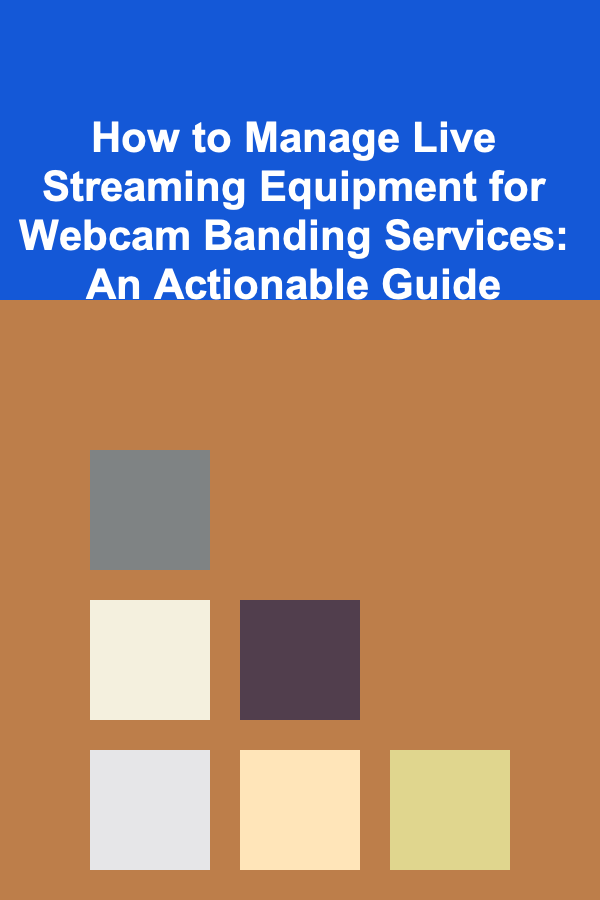
How to Manage Live Streaming Equipment for Webcam Banding Services: An Actionable Guide
ebook include PDF & Audio bundle (Micro Guide)
$12.99$10.99
Limited Time Offer! Order within the next:

Live streaming has become a powerful medium for various industries, from gaming and education to business and entertainment. One particular niche that has grown in popularity is webcam banding services, where individuals or companies use live streaming equipment to provide real-time video content to their audience. However, managing the technical aspects of live streaming equipment, especially for webcam banding, requires a thorough understanding of both the hardware and software involved.
In this guide, we'll dive deep into the essential steps for managing live streaming equipment for webcam banding services. Whether you're just starting or looking to optimize your current setup, this comprehensive guide will help ensure smooth operations, high-quality streams, and an overall professional experience for both you and your audience.
Understanding Webcam Banding Services
Before diving into the equipment specifics, it's important to first understand what webcam banding is and the unique challenges it presents. Webcam banding is the process of using a webcam (or similar camera) to stream live video content to viewers. This can involve everything from a simple personal stream to highly professional broadcast-like setups.
Unlike traditional film or broadcast media, webcam banding typically focuses on content that is more direct, interactive, and engaging, often involving real-time feedback from the audience. Given this interactivity, maintaining high-quality video, audio, and overall stream performance is crucial for user engagement.
Choosing the Right Webcam for Your Needs
The webcam is the core piece of equipment for your live stream. The quality of your webcam will directly affect the video quality for your viewers, and understanding how to select the right one is critical.
Key Considerations for Choosing a Webcam:
- Resolution: Ensure the webcam supports at least 1080p (Full HD) or 4K resolution for sharp, clear video. Lower resolution webcams (720p) may be sufficient for casual streaming, but they could detract from professional content.
- Frame Rate: Higher frame rates, such as 60 frames per second (fps), are ideal for smoother video, especially if you're streaming fast-moving content.
- Autofocus: Look for webcams with autofocus capabilities to keep the image sharp, especially if you're moving around or changing your position during the stream.
- Low-Light Performance: A webcam with good low-light performance will help maintain video quality even in less-than-ideal lighting conditions.
Top webcams for live streaming include options from Logitech (e.g., Logitech Brio, C920) or the Razer Kiyo, which comes with built-in lighting.
Setting Up Your Camera and Mounting Equipment
Proper positioning of your webcam and camera mount is essential for achieving the best video quality. Whether you're using a desk setup or a more complex rig, follow these tips for optimal camera placement.
Key Considerations for Camera Setup:
- Camera Height: Position the camera at eye level to create a more natural and engaging view. This will prevent awkward angles and create a more personal connection with your audience.
- Camera Stability: Use a sturdy mount or tripod to prevent shaky footage. Even small movements can be distracting for viewers.
- Lighting: Good lighting is crucial. Set up soft, even lighting around the camera, and avoid direct light sources that could cause harsh shadows. Ring lights or softboxes can be used to enhance your appearance and reduce harsh shadows.
Lighting and camera positioning directly affect the quality of the stream, so make sure these are optimized before you begin broadcasting.
Audio Equipment for Clear Communication
Webcam banding often relies on clear audio to maintain engagement. Viewers need to hear the speaker clearly, and any background noise or audio distortions can detract from the experience.
Key Audio Equipment for Live Streaming:
- Microphone: Invest in a good external microphone. While most webcams have built-in microphones, they often produce poor sound quality. USB microphones like the Blue Yeti or Audio-Technica AT2020 provide excellent audio fidelity.
- Audio Interface: If you're using an XLR microphone (which offers superior sound quality), an audio interface or mixer (like the Focusrite Scarlett 2i2) will be necessary to convert the signal to a usable format for streaming.
- Headphones: Use closed-back headphones to monitor your own audio during streaming, ensuring that you're aware of any potential issues.
- Pop Filters and Windshields: These accessories help reduce plosives (popping sounds caused by "P" and "B" sounds) and can significantly improve sound quality.
Streaming Software and Configurations
Streaming software is the backbone of your webcam banding service. It allows you to control video feeds, manage overlays, and interact with your audience in real-time.
Popular Streaming Software:
- OBS Studio (Open Broadcaster Software): A free, open-source software with a vast array of features, including scene transitions, multi-source inputs, and real-time video encoding. OBS is highly customizable, making it ideal for professional setups.
- Streamlabs OBS: A more user-friendly version of OBS, designed specifically for streamers. It has built-in templates for alerts, overlays, and widgets, making setup quicker.
- XSplit: Another popular streaming platform that's great for those looking for an easy-to-use interface, but it comes with a premium cost.
Key Configuration Tips:
- Bitrate: Adjust the bitrate based on your internet speed. Too high a bitrate and your stream could stutter, too low and it could result in poor image quality. A bitrate of 3000--6000 kbps is often recommended for 1080p streaming.
- Scene Transitions: Set up different scenes for various parts of your stream (e.g., intro, main content, Q&A, closing). You can use these scenes to display images, text, or even live video feeds.
- Overlay Design: Custom overlays with your brand or content information can add a professional touch. Use tools like Canva or Streamlabs to create overlays that match the theme of your stream.
Internet Connection and Bandwidth Management
A stable and fast internet connection is perhaps the most important factor for successful live streaming. Without a strong connection, your video may freeze, buffer, or drop out entirely.
Best Practices for Managing Your Internet Connection:
- Wired Connection: Always opt for a wired Ethernet connection instead of Wi-Fi. This provides a stable and more reliable signal with fewer interruptions.
- Upload Speed: Test your upload speed before streaming. Aim for at least 5 Mbps for 1080p streaming. For 4K streaming, aim for speeds of 25 Mbps or higher.
- Backup Connection: If you can, set up a secondary internet connection (such as a mobile hotspot) as a backup in case your main internet goes down.
Monitoring and Troubleshooting During a Stream
Once your equipment is set up and you're live, it's important to monitor your stream for potential issues. Constantly check the video feed, audio quality, and viewer feedback to ensure everything runs smoothly.
Tips for Real-Time Troubleshooting:
- Test Before Streaming: Always do a test run to check for any technical issues before going live. This allows you to troubleshoot and resolve problems in advance.
- Use Stream Monitoring Tools: Platforms like Twitch, YouTube, and Facebook provide stream health statistics that allow you to monitor bitrate, CPU usage, and dropped frames in real-time.
- Engage with Your Audience: Pay attention to audience feedback, especially if there are issues with video or audio quality. Viewers often notify you of problems, so it's crucial to stay interactive and responsive.
Post-Stream Equipment Maintenance and Updates
After a live stream, it's important to ensure your equipment is properly maintained for longevity and optimal performance.
Post-Stream Checklist:
- Clean Your Equipment: Dust and dirt can accumulate on your cameras and microphones. Gently clean lenses and microphones with appropriate cleaning tools.
- Update Software: Ensure that both your streaming software and drivers for your webcam and audio equipment are up to date to avoid bugs and issues in future streams.
- Backup Your Content: If you're recording your streams, make sure to back up the footage to avoid losing valuable content.
Conclusion
Managing live streaming equipment for webcam banding services is a multifaceted process that involves attention to detail in both hardware and software. By investing in the right equipment, setting up your streaming space thoughtfully, and optimizing your stream for stability and quality, you can provide a professional and enjoyable experience for your audience. Always stay on top of maintenance, troubleshoot during the stream, and continuously improve your setup based on feedback and performance. With these practices in place, you'll be well on your way to mastering webcam banding for live streaming.

Creating Passive Income Streams with Deep Learning
Read More
How to Invest in Low-Cost ETFs and Beat High-Fee Mutual Funds
Read More
How to Soundproof Windows Using Low-Cost Materials
Read More
How To Understand the Basic Steps of Wine Tasting
Read More
How to Make Quick Breads (No Yeast)
Read More
How To Grasp the Ethical Debates in Genetic Research
Read MoreOther Products

Creating Passive Income Streams with Deep Learning
Read More
How to Invest in Low-Cost ETFs and Beat High-Fee Mutual Funds
Read More
How to Soundproof Windows Using Low-Cost Materials
Read More
How To Understand the Basic Steps of Wine Tasting
Read More
How to Make Quick Breads (No Yeast)
Read More